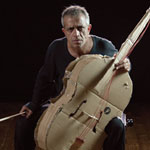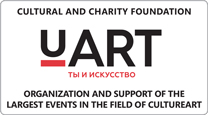29 November 2016
Honey from a jar and a tarantula bite
Text: Sergey Khachaturov
Photo: Eugene Evtyukhov, Kirill Kudryavtsev, Denis
Kuznetsov
The 8th VIVACELLO Festival, held as
usual at various Moscow venues under the management of Boris Andrianov and the
culture and charity foundation U-Art: You and Art, has exposed certain
important issues concerning interpretation and perception of music written for
so unhurried an instrument. (Osip Mandelstam likened the density of the cello
timbre to honey flowing from a tilted glass
jar)
|
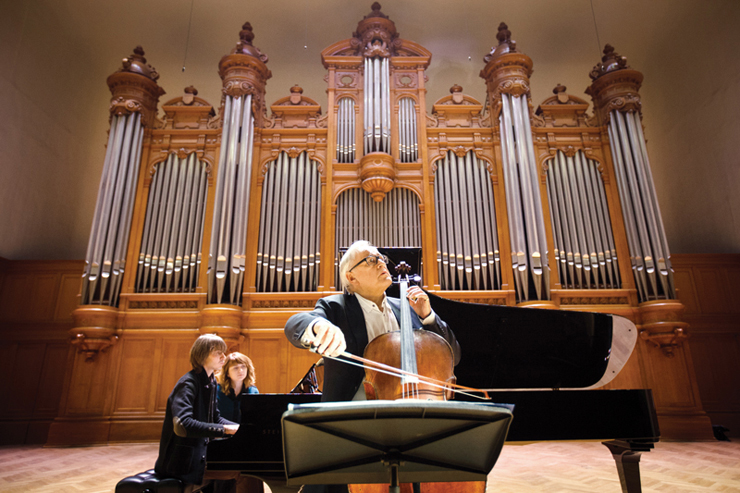
David Geringas and Philipp Kopachevsky
|
This year's program has been especially recherché. The
audience was treated to the Concerto for Cello, Strings and Basso Continuo
composed by one of the first creators of cello concertos of the 18th century,
the Neapolitan Leonardo Leo, in a striking rendition by the eccentric wizard
Giovanni Sollima.
|
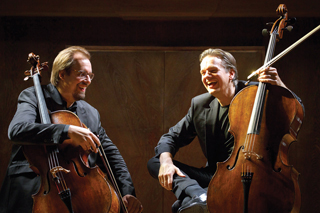
Younger maestros Jens Peter Maintz and Wolfgang
Emanuel Schmidt
|
We attended the musical act «Rivers and streets. Joseph
Brodsky,» which the performers Valeria Kogan, Artur Smolyaninov, and Boris
Andrianov described as a «rhyming-instrumental construction for three
instruments and vocal based on Joseph Brodsky's observations and sketches in
verse.» All Beethoven's sonatas for cello and piano were played by Andrianov's
teacher David Geringas and pianist Philipp Kopachevsky.
Geringas' two other students, younger maestros with
professor-like demeanor Jens Peter Maintz and Wolfgang Emanuel Schmidt,
presented a program for musical gourmands entitled Cello Duello: a series of
brilliantly written and accurately performed dueling duets for two cellos, from
Haydn to Popper. Truly, the festival offered plenty of great, delightful, and
magnificent music. Even the unfinished Prokofiev's piece, Concertino for Cello
and Orchestra (completed later by Mstislav Rostropovich and Dmitry Kabalevsky),
braced with the Russia premiere of Giovanni Sollima's tarantula dance concert
and Spanish music of the late 19th−early 20th century performed in homage to
Pablo Casals, acquired extraordinary elegance.
It was only to be expected that by the 8th Festival this
garland of styles, techniques and traditions raised the question of the
audience. I can tell a priori what Boris Andrianov's answer would be: the more
people with different music tastes comes to the event, the better it is, the
more diverse, and the higher the attendance rate. This answer is a feat of
diplomacy. It leaves out the question's finer points, however.
|
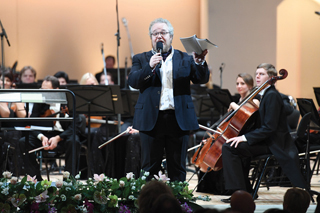
Music critic and VIVACELLO host Artem Vargaftik
|
Like the previous ones, the 8th festival has marked the anniversaries of great
performers. Boris Andrianov's mentor David Geringas celebrated his 70th
birthday. This year all music lovers commemorated the 140th anniversary of the
Catalan cellist Pablo Casals, the Rembrandt of cello. He set the standard of
grasping the volume, the space, all the folds of the very sound matter. With
every stroke he worked in such a manner that one can only exclaim,
Eureka!
This is what perfection means!
I own two old CDs, The Six Suites for Cello by Johann
Sebastian Bach. The first is recorded by Pablo Casals, the second — by the
outstanding French cellist Pierre Fournier. Fournier's sound sings, beautiful,
graceful, magical. Casals, on the other hand, is a priest in a country church.
His sermon flows quietly, and suddenly a small strand of light in it grows into
an incredible expanse of the sound space — for example, in the Sarabande from
the Second Suite it is this perfection of posing the ultimate questions about
God, Universe, and Man. It is truly akin to Rembrandt or, perhaps, to Piero
della Francesca.
|
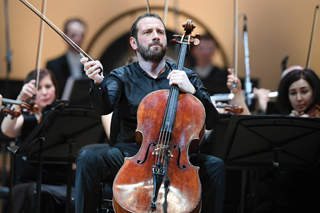
VIVACELLO Art Director Boris Andrianov
|
In the festival program, the homage to Casals took form of the final concert,
full of baroque splendor. It was beautiful all throughout. After it ended, I
asked young students of the Moscow Conservatory how they liked it. They were
beaming and started telling me excitedly how cool Giovanni Sollima's
performance was — «temperamental», «expressive», «always right on the money»,
«that was something», «that was something else entirely», «a ride with a
tiger»). Their praise for Bohórquez and Prokofiev was more reserved, «the lows
had an interesting timbre,» and — alas — quite tepid for Boris Andrianov,
«everything was classical, befitting the art, harmonious, but nothing special.
»
I believe, of course, that such remarks have every right to
exist, even more so when coming from professionals. However, after viewing the
concert time and again at Meloman.ru, I once more realized how carefully
transcribed, how singlemindedly, with a scholarly thoroughness even, were three
Spanish pieces (by Albeniz, Granados, and de Falla) combined into a whole by
Boris's friend Rem Urasin. Andrianov performed them with the Russian
Philharmonic Orchestra (conductor Vahan Mardirossian). This was the birth of a
new opus out of existing ones, named by the host Artem Vargaftik a «small
Spanish concertino.» Intense dancing, melancholic, passionate, poetic themes
were rendered by Andrianov in their finest subtlety, in complete union with the
orchestra, transparently and in sparkling detail.
|
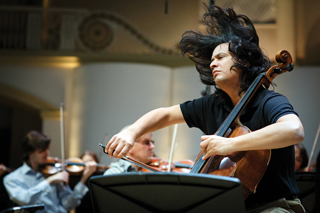
Claudio Bohórquez performing Sergei Prokofiev's
Symphony-Concerto
|
And Claudio Bohórquez erected Prokofiev's edifice with equal
sense of space and finesse. But to be sure, when we are faced with an aural
narration — augmented with a fiery drive — about fighting tarantula bites with
dancing in the South Italy, which causes the Tarantella dance to come into
being — to be sure, all comparison is futile. It's like letting children and
puppies onto a movie set: they will outplay everyone else. Especially given
that Sollima is a great professional as well, and the magic concoction of
different styles and techniques that he offers the audience is of the highest
standard.
Of course, the younger generation's thoughts on musical
priorities can be treated with a dose of humor and explained by the
all-pervading consumerism and unwillingness to hear the quiet and sense the
subtle. However, for some reason it was Casals that came to my mind: in his
day, crazy festivities not always assumed cascades, can-cans, and tarantellas
all at once. Back then it was easier to hear a pause, to sink into
contemplative awareness. Here is a radical proposal: in order to further
nurture intelligent audience at VIVACELLO, it would be nice to have one concert
for only one great piece. And have Vargaftik comment, and include different
editions, and with all the allusions and cultural codes have it performed by at
least five world's renowned cellists!
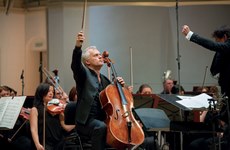
Torleif Thedéen at the opening
concert
|
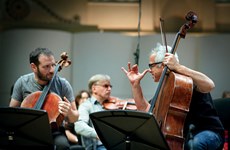
Boris Andrianov and Giovanni Sollima at the rehearsal before the premiere
|
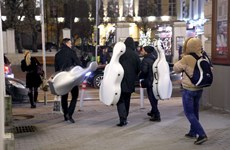
The VIVACELLO Festival will return to Moscow next fall
|
7 December 2016
At the Vivacello festival, the Italian cellist and composer performed his Antidotum Tarantulae XXI concert for the first time in Russia. This “modern antidote for tarantula bite” stirred, probably, most discussions in the press and among the festival visitors alike. The expressive modern music is in conversation with the past, with the Renaissance and Baroque — and for explanations we turned to Giovanni Sollima himself
2 November 2016
Art Patrons Iveta and Tamaz Manasherov Participate in a Pompidou Center’s Project. The collection of Russian art in the P ompidou Center is well-known internationally and includes works by Kandinsky and Malevich,
Chagall and Pevzner, Puni and Exter, Bulatov and Kabakov - great names and seminal works all throughout ...
3 October 2016
The exhibition entitled “Apartment no. 5: To the History of the Petrograd Avant-Garde, 1915–1925” was presented at the Marble Palace in St. Petersburg, supported by Unident Group and U-ART Cultural Charitable Foundation presided by Iveta and Tamaz Manasherov.
9 June 2016
The subject of music and art is a most captivating and treacherous one. It entices us with seemingly beautiful parallels and juxtapositions, with the ease of new discoveries.
3 June 2016
The VIVARTE First International Chamber Music Festival (organized with the support of UNIDENT Group of Companies) has ended in Moscow The concept of the festival was the synthesis of arts. VIVARTE unites chamber music and painting, traditions and avant garde. Eight days, six concerts, six masterpieces from the museum vault, 25 participants, “musical promenade” and jazz night.
Back









